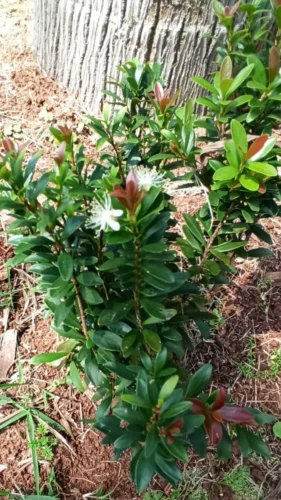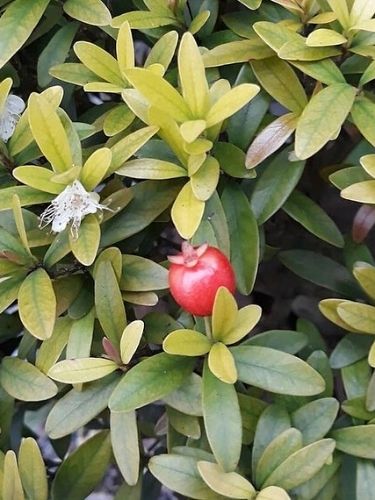
The dwarf surinam cherry (Eugenia mattosii) stands as an evergreen, woody, fruit-bearing, and ornamental shrub hailing from the Atlantic Forest in the states of Santa Catarina and Paraná, Brazil. It showcases a dense, rounded canopy with abundant branching from the base. The trunk boasts a dark brown color and vertical fissures. The leaves are simple, small, oblong to spatulate, opposite, coriaceous, and glossy. They take on a reddish hue when young, transitioning to green as they mature, casting a coppery effect during the shrub’s growth phase. Inflorescences grace the scene in spring, arranged axillary, forming clusters of 2 to 8 flowers each. The hermaphroditic flowers don a white shade, accompanied by numerous long stamens, emitting a mild fragrance. These flowers produce copious nectar and pollen, enticing native bees and other pollinators.

Summer ushers in the arrival of small, spherical berries that resemble fruits. Colored red, they feature a persistent calyx, fleshy pulp, and a sweet flavor, enclosing one or two seeds each. Their aroma and taste parallel those of the surinam cherry (Eugenia uniflora) and the cherry of the Rio Grande (Eugenia involucrata). They can be enjoyed fresh or transformed into refreshing juices, jams, and sorbets. Additionally, the fruit of the dwarf surinam cherry magnetizes various bird species. In general, both flowers and fruits thrive more intensely when the plant is cultivated in the southern regions of the country, where distinct seasons occur.
Within garden landscapes, the dwarf surinam cherry excels as a versatile contender, capably supplanting exotic shrubs like the boxwood (Buxus sempervirens) and the Chinese privet (Ligustrum sinense). It notably produces edible fruits. It may stand alone, form groups, serve as hedges, or companionably exist alongside other plants, particularly those that contrast its fine texture and coppery green tones. Adaptable to pruning, it presents dense and robust foliage, ideal for formal and informal topiaries, borders, and hedges.
It can gracefully define garden entrances or accentuate walls. Furthermore, it’s an endangered species with a pivotal ecological role in attracting pollinators and nourishing avifauna, further elevating its significance in Brazilian landscaping. Rarity in cultivation lends an air of uniqueness to projects. Container cultivation adorns sunny patios and balconies. Petite leaves and fissured woody stems make it an excellent choice for bonsai art. Effortless to cultivate, it grows gradually, necessitating uncomplicated maintenance encompassing pruning, shaping, and fertilization.
Cultivate it under full sun in fertile, well-draining, and organic-rich soils. Once established, supplementary watering proves beneficial in the garden. It withstands frost 26,6ºF (-3°C) and brief periods of drought. Moreover, it adapts to diverse climatic conditions, flourishing from sea level to high altitudes (3280 ft) across Brazil. Ideally, fertilize in early spring and summer using organic fertilizers like bone meal and well-rotted poultry manure, or mineral fertilizers such as NPK formulations suitable for fruit-bearing plants, adhering to the manufacturer’s guidelines.
Prior to fertilization, water the plant to avert root burns. Dwarf surinam cherry trees propagate easily from seeds or cuttings of young branches. For planting, sow the seeds shortly after fruit harvest, as their viability diminishes rapidly. Germination occurs unevenly, spanning 40 to 90 days. Pinching the tips of young seedlings promotes denser growth. Dwarf surinam cherry trees typically commence fruiting approximately 2 to 3 years post-planting.



